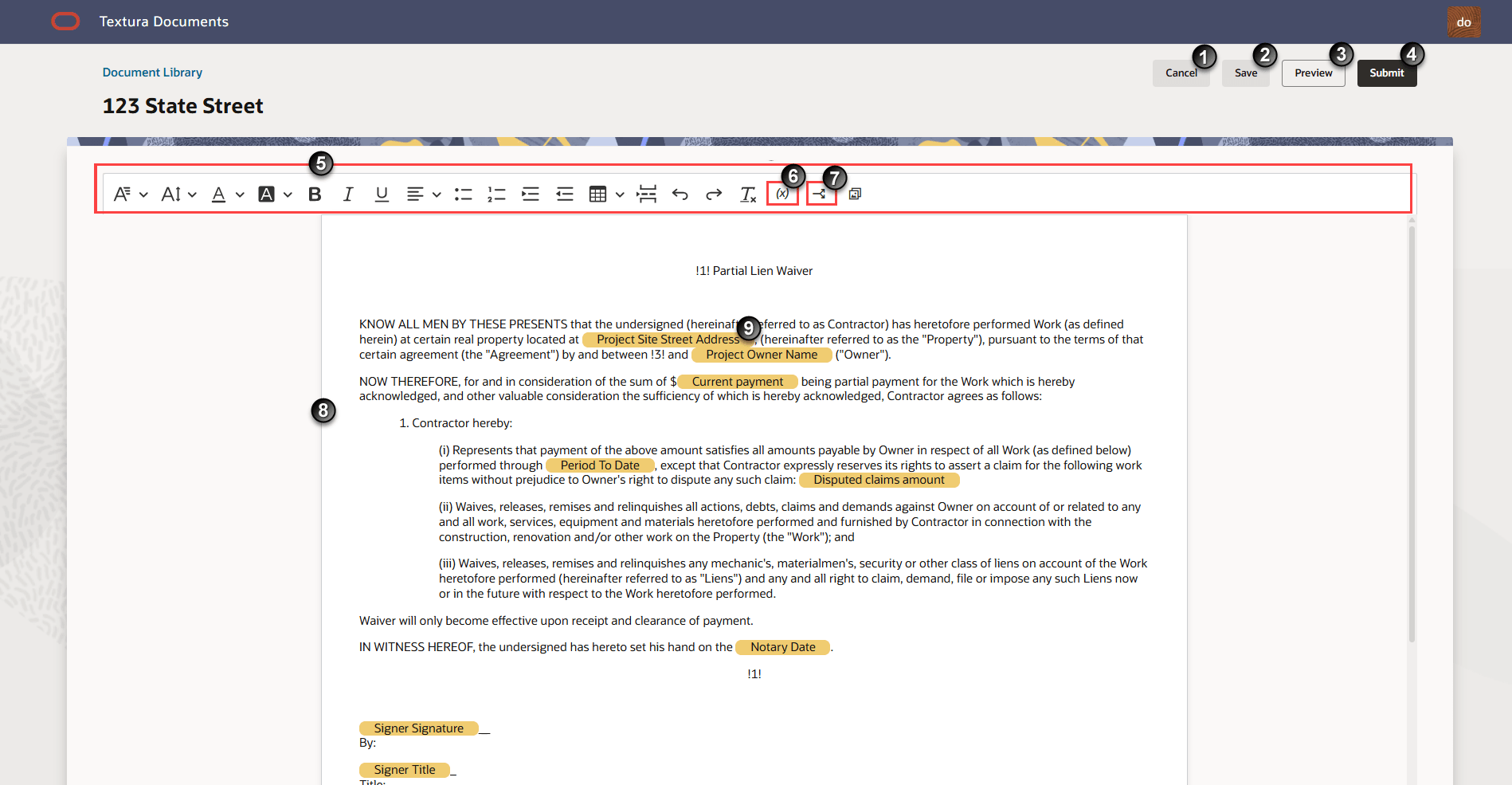Working with the Documents Editor

- Cancel: Cancel document template editing and return to the Document Library page.
- Save: Save your most recent changes to the document template. Consider frequently saving your work to prevent accidental loss of content if you navigate away from the page or experience a connection issue.
- Preview: Generate a preview of the document template. When you preview a document template, you will pick a project, contract, and draw to use as context for the preview so you can visualize how the document will look when presented to a Signer.
- Submit: Save and submit the document template for publishing. The document template's status changes to In Review on the Document Library page.
- Document Editor Ribbon: Change the format of text in the Document Editor or add a plugin.
From left to right, available formatting options include:
- Font Family: Select a font for the document template. Available options include Helvetica, Times New Roman, and Courier New.
- Font Size: Control the size of the font in the document template. The Default option applies size 12 to your font. You can select a minimum size of 1px and a maximum size of 18px.
- Font Color: Change the color of the font in your document template. Either choose a predefined color or use the color picker tool to enter a hex code or select a color from a color map.
- Highlighter: Highlight a section of text in the document template. Either choose a predefined color or use the color picker tool to enter a hex code or select a color from a color map.
- Bold: Apply bold or strong styling to text.
- Italic: Apply italic styling to the text.
- Underline: Underline text in the document template.
- Text Alignment: Choose how to align text in the document template. Alignment defaults to left-aligned, but you can choose to align the text right, center, or justified.
- Bulleted List: Add a bulleted list to the document template. You can also create sub-bulleted lists by increasing the indentation of a bullet.
- Numbered List: Add a numbered list to the document template. You can also create sub-numerical lists by increasing the indentation of a numbered list. The first level of a sub-numerical list will adopt a lower-alpha formatting. A sub-numerical list under a lower-alpha formatted list will use lower-roman formatting.
- Increase Indent: Increase the indentation of text on the left side of the document template.
- Decrease Indent: Decrease the indentation of text on the left side of the document template.
- Insert Table: Insert a table into the document template. After adding a table, you can use the Table Menu to add or remove rows and columns, change background colors, and select border settings.
See Adding a Table to a Document Template for more information about how to add and edit tables in the Documents Editor.
- Page Break: Add a page break to your document template. A page break will move you to a new page in the document template
- Undo: Undo the most recent action you took in the Document Editor.
- Redo: Only available after you undo an action. Reverse the most recent text or formatting you chose to undo.
- Remove Format: Remove the formatting you applied to text in the Document Editor.
- Plugins: The text ribbon includes variable options for the document template. Refer to numbers 6 and 7 for more details.
- Insert Image: Add an image to the document template. Textura supports both JPEG and PNG file types. After adding an image, you can move and resize it within the template. The image will display in both the document template and any previews of the template that you generate.
- Variable Plugin: Select the icon to open a drawer on the left side of the page. From the drawer, you can select a plugin to pull data from a project, contract, or draw into the document template.
For example: Select the Project Name standard variable to insert the Textura project name into the document at the time of signing, or select the Signer Signature Signer variable to add a placeholder for the electronic signature of the Signer of the document.
- Conditional Plugin: Select the icon to open a drawer on the left side of the page. From the drawer, you can use tools to insert Start and End Tags to define conditional logic Textura will apply to the content of the document.
For example: In the case of a final invoice, specify "If Final" Start Tag and End Tag to display text that is specific to a Full and Final Lien Waiver. When a user signs a full and final lien waiver, the content entered between the Start Tag and End Tag displays in their document. This content will not display on a progress lien waiver.
See Using Conditional Start and End Tags in Documents for how to create and use a conditional plugin.
- Variable Pill: Signifies the addition of a variable to the document template. Variable pills help you visualize the placement of key information in your document template.
Last Published Friday, December 5, 2025